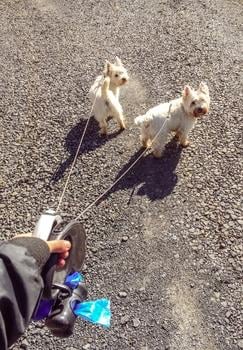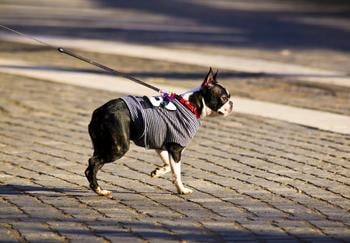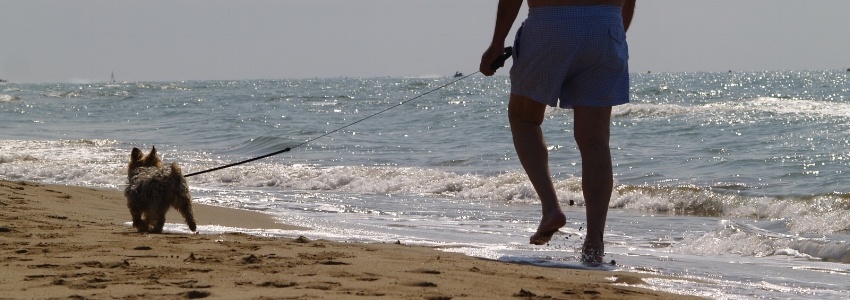 Retractable leashes are quite appealing for a variety of dog owners. Many want to give their dog more freedom to move about, not hindered by the slower walking pace of us humans. Some find it easier to use a retractable leash because it means they don't have to manage the length of a regular leash. Really, it's all about the convenience factor.
Retractable leashes are quite appealing for a variety of dog owners. Many want to give their dog more freedom to move about, not hindered by the slower walking pace of us humans. Some find it easier to use a retractable leash because it means they don't have to manage the length of a regular leash. Really, it's all about the convenience factor.
While convenience is certainly something I tend to aim for when it comes to helping my dog training clients, retractable leashes come with quite a few issues that you may not be aware of.
Many dog trainers don't like retractable leashes and don't allow them in their training classes (myself included). Instead, we recommend using a long leash. Why is that? Because the dangers of retractable leashes and the negative behaviors they can cause or reinforce outweigh how convenient they may be.
Let's look at why retractable leashes can make dog training more difficult and why using a retractable leash can be dangerous, even if you're using a "safer" retractable leash style.
Skip Ahead
Reasons to Avoid Using a Retractable Leash
How Retractable Leashes Can Ruin Your Dog Training
Flexi-leashes are constantly adding tension to the leash. Usually, our goal with loose leash walking is to have a dog walk with some slack in the leash. In classic leash training, any tension in the leash predicts no more forward motion (what the dog wants) or signals a change in direction. So, our goal is to teach the dog that if they keep the leash loose, they get to continue on their walk. That's a hard association to make if there is always tension on the leash! On retractables, dogs learn that to move forward, there needs to be tension on the leash. Basically, they must pull to get where they want to go.
If you have a puppy, starting them off on a retractable leash can make leash training harder as they mature because of the constant tension on the leash cord. Start your puppy out on a regular flat leash and practice their leash manners (and recall!) before considering a retractable leash. Already started using a retractable leash with your pup? That's okay! Just switch to a regular leash and focus on teaching loose leash walking.
As I mentioned earlier, many dog trainers do not allow retractable leashes in group class environments. This is because they are bulky and hard to handle for the human student, as well as making it difficult to maintain appropriate distances from the other dogs. If the leash gets accidentally unlocked, that dog can now rush up to other dogs (who may be frightened or unsure) or other people. That's not learning good habits and is putting others at risk.
There are better alternatives to retractable leashes, and they come in all lengths depending on your needs. See more on options I recommend for my clients in Choosing Your Dog's Leash, but here is a rough guide:
- 4 or 6-foot leashes for regular walks in busy environments or during a training class
- 10+ foot long leashes for sniffaris, hiking, recall practice
- If you're a city dweller, you can even choose a 2-foot traffic leash (or choose a 6-foot leash with a traffic handle addition) for closer safety and control

Retractable Leashes Make Leash Handling Hard
Retractable leashes are not ideal for safe and effective leash handling by the human. And leash handling skills are crucial for safety, effective loose leash walking training, or other issues like leash reactivity.
- The design of flexi-leashes means that the handle and "storage" area for the retractable cord are quite bulky. This makes it hard to easily transfer between hands or untangle if it gets wrapped around you or your dog.
- Retractable leashes aren't able to be easily handled with two hands. For strong dogs, using two hands on a regular leash is safest and provides better feedback through the leash to the dog.
- Walking two dogs on retractables increases the leash handling difficulty (and safety risks outlined above). It's hard enough training multiple dogs to walk politely on leash at the same time using regular leashes — imagine how hard it is on retractables when they decide they want to go in opposite directions!
Retractable Leashes Can Cause Injuries
- Burns and cuts on the fingers, legs, and other body parts of people when the cords or bands of the leash quickly brush by or become wrapped around them. Handlers and passers-by have suffered these types of injuries.
- Similar injuries have happened to dogs, too. Both the dogs being walked with a retractable leash and those who weren’t but got entangled by one who was.
- Finger amputations on people when the band or cord of the leash gets wrapped around the digit.
- Eye and facial injuries when the plastic handle or the metal clip of the leash breaks or recoils out of control. Here's a true story of a young woman who lost her eye using a retractable leash while walking her husky.
-
Neck or shoulder injuries to dogs — and not just causing them, but also making them worse! These leashes provide a long “runway” and an opportunity for your dog to get a running start when seeing another dog, person, squirrel, bird, or anything else your dog wants to chase or run to. These scenarios often end in one of two different ways:
1) A dog gets a huge jolt when they reach the end of the leash — putting an extremely high amount of stress on their neck — worsening any existing neck pain (pinched disc, etc.), and potentially causing serious damage.
2) You let go of the leash to avoid snapping their neck (and possibly your shoulder, as well). Now your dog is running loose and dragging their retractable leash through the park or streets. This is never a good situation.
 Safety Risks of Using a Retractable Leash
Safety Risks of Using a Retractable Leash
- Bolting. Many dogs will startle (understandably) if the handle of the retractable leash is accidentally dropped and try to run away. Not only can this result in a lost dog situation, but a dog may run into busy traffic areas. This puts them at high risk of being hit by a car.
- Wandering into Trouble. Retractable leashes mean a dog can put much more distance between themselves and their walker. If your attention wanders, even for a moment, that could mean your dog bolts into the road unexpectedly. And you have no fast way to grab up the ten-plus-feet of the leash cord to pull them out of the way of oncoming traffic.
Or they could go around a corner and come face-to-face with another dog who may be frightened of other dogs or react aggressively. The fact that retractable leashes don't have an option for "reeling in" the cord — instead, requiring you to take in length as you move up to your dog, locking the leash as you go — makes responding to these situations incredibly difficult! - Getting Tangled Up or Caught. All long leashes, retractable or not, can get caught on branches, wrapped around trees, rocks, or other terrain. However, retractable cords tend to break more easily than more robust long-lead materials.
Retractable Leashes Aren't Always Bad
So now that we've gone through the dangers of retractable leashes, I want to mention that there are some instances where they can be really convenient to use and not hinder your dog's training. When used responsibly and in the right environment, retractable leashes can be a good way to allow your dog to have a greater sense of freedom and get a bit more exercise while still staying attached to you. With that said, it is my professional opinion that it's always better to use a fixed-length, long leash instead.
When It's Okay to Use a Retractable Leash
Retractable leashes should be reserved for only well-trained, reliable dogs. A dog should be able to walk politely on a loose leash before being introduced to a retractable leash. It's also essential for a dog to have a reliable recall when on a retractable leash, so you can quickly call them back to you when needed.
Only use retractable leashes in settings and situations where the likelihood of encountering another person, dog, or other distraction is very low. In all other situations, it’s best to opt for a regular or long leash. Places that might be okay to use a retractable leash include beaches, open fields or meadows, or open trail paths. And even in these locations, extreme caution should always be used, like with cliffs, bluffs, and wildlife.
Only adults should use a retractable leash. Never let a child use a retractable leash — it's just too dangerous and not worth the risk.

Are Some Retractable Leashes Safer than Others?
I have yet to find a retractable leash with safety measures that mitigate the risks that make me so hesitant to use these leashes. Well-known and higher quality brands, such as Flexi®, have specific usage and safety guidelines that are important to review prior to use.
If your dog is a good candidate and you feel comfortable using a flexi leash, make sure to choose the right size for your dog's weight, get comfortable with the braking system, and follow the manufacturer's use and safety instructions. You'll also want to consider whether a tape or cord-style retractable leash is best for your dog's size and strength.
Never Use a Retractable Leash If:
- You walk your dog using a head halter (such as a Gentle Leader or Halti)
- Your dog is walked using a prong, choke, or other aversive collars
- Other dogs, people, and especially children are around
- You are within reach of traffic, cliffs, or other hazards
- You are in busy locations such as street fairs, crowded sidewalks, bike trails, or dog parks
- Your dog has had any prior neck or back injury
- Your dog is more powerful than you are
- Your dog is in training or has any type of behavioral issues
- You are walking more than one dog at a time
- You are a child under the age of 14
- When using an elevator with your dog
All these circumstances can lead to danger or injury – for both you and your dog.
If you want to teach your dog how to comfortably walk on a regular "loose" leash try out these training tips, and check out this article for tips and advice on choosing the best leash for your dog. Transitioning your dog to a better and safer leash from a retractable leash (if you've already been using one) isn't difficult.



